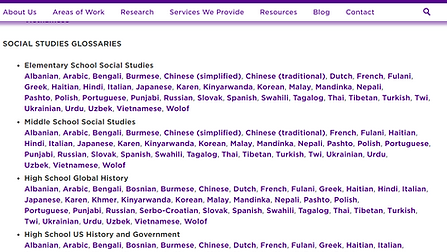Learning Experience 1
Week 1/ Lesson 1, 2, 3
This week's lessons introduce the unit about Industrialization and specifically the Industrial Revolution.
Students will be hooked into the unit by introducing them to the idea of inventions and innovations. They will be given the opportunity to dive deeper by learning about inventions made by peers their own age.
This will allow them to examine why inventions happen and also that
inventions are not restricted only to scientists or adults. Inventions can come from anywhere in the world and from anyone at any age.
The unit's relevance will be made apparent by informing them of the 4th Industrial Revolution they are living through!
Summary
Learning Outcomes
Advancements and inventions originate from a strong need.
Why do people invent?
Standards
4.6 WESTWARD MOVEMENT AND INDUSTRIALIZATION: New York State played an important role in the growth of the United States. During the 1800s, people traveled west looking for opportunities. Economic activities in New York State are varied and have changed over time, with improvements in transportation and technology.
RI.4.4 Determine the meaning of general academic and domain-specific words or phrases in a text
(Standards: 1, 3, 4; Themes: MOV, TCC, GEO, ECO, TECH)
practice
focus
Economics and economic systems:
Explain what necessitates decision making
Gathering, interpreting and using evidence:
Create an understanding of the past by using primary and secondary sources.
learning
Theme
Science, Technology, and Innovation (TECH)
Kind of Learning
Acquisition (A)
Meaning Making (M)
Transfer (T)
4C's
-
Communication
-
Collaboration
-
Critical Thinking
-
Creativity
Instruction
Online
iMovie/Quicktime video of slides with voice over
In Class
PPT
Assessment
Google slides for students to add their own slides and allow for collaboration
Flipgrid for presentations
Essential
question
Enduring Understanding
What the student will see/read/listen to/think about/ do
Understanding Vocabulary specific to the unit
How this "revolution" is different from the American Revolution or a war and represents change.
Vocabulary Focus: Innovation
goods, manufacture, factory are explained in English and in languages of students
The Social studies glossary can be provided to all students as required to further deepen understanding and encourage home language, discourse specific acquisition.
Information about the resource
Teaching Resource
Text: How Machines Changed Culture. Industrial Revolution for Kids - Baby Professor
Text: Industrial Revolution for Kids - Carla Mooney
Differentiation Resource:
Glossaries for ELL learners
Teaching Resource
Text: How Machines Changed Culture. Industrial Revolution for Kids - Baby Professor
Visual Reference or Link for the resource
Why the resource is relevant to learning
Students need to understand discourse specific language before they can move into deeper acquisition and meaning making.
A brief introduction to the two Industrial Revolutions we will focus on in this unit.
Kind of learning or assessment
Learning: Acquisition
Time frame of the Industrial Revolutions
The first and second Industrial Revolutions spanned a period of 200 years.
In order to make sense of the upcoming information in terms of inventions and the history of the US, students needs to know the time frame of the revolution.
Learning: Acquisition



Teaching Resource
Text: Industrial Revolution for Kids - Carla Mooney


Why is it important for me to learn this?
First IR: Textiles
Second IR: Electricity
Third IR: Electronics & IT
Fourth IR: Cyber & Physical realms
We are living in this age now!
In order to make sense of why they are learning about this unit, students must be able to see that this learning is relevant to them more than ever today.
Learning: Acquisition
Meaning Making
Transfer

Teaching Resource
Image: Four Industrial Revolutions
Kid Inventors & Innovators
Video
Text
Graphic Organizers
Students watch a video about kid inventors. The focus of the video is on inventions and innovations by children today and what motivated them to make these.
Students also read two text excerpts about Braille and Popsicles and complete a graphic organizer that asks them to choose one invention/innovation that they thought was specifically important, helpful or complicated.
Students get an opportunity to see peers from today's time creating inventions. The inventions are not all scientific but span multiple categories from popsicles, umbrellas to coding for the visually challenged.
These sources allow students to start thinking about how innovations of inventions can bring about major changes or are sometimes just as important than the original.
The organizer lets them communicate which invention they felt had the most impact or was complex . Allowing for higher order thinking.
Learning:
Meaning Making
Assessment:
Formative
4C's
Critical Thinking
Creativity
Communication
Student Resource
Video: The New Yorker - Kid Inventors Tell All
Step/ Experience
Resource
Visual/Link
Purpose/ Rationale
category
Know Wonder Learn
What do students know at this point?
What do they wonder about?
The learned column will be revisited at the end of the unit as part of a reflection in their performance task.
Student Resource
Graphic Organizer
KWL chart

Students start their own inquiry process by completing a KWL Chart about inventions.
Learning:
Meaning Making
Assessment:
Pre-assesment
4C's
Critical Thinking
Group Activity
Students work in groups of 3 to brainstorm at least 3 ideas that would help their communities or people in their lives.
This will require each student to contribute and partake in discussion.
Student Resource
Graphic Organizer
Brainstorm

Differentiation Resource:
Presentation of ideas:
Flipgrid Videos OR
In Class Presentations

Students work in groups to come up with a list of things they believe would make their communities better.
Groups will select one of their ideas and
present it to the class.
They can choose to use either Fipgrid videos or in class presentations.
Allowing students to design/sketch their idea and offering choice in terms of their means of expression, both allow for students to make choices that support their learning.
Learning:
Transfer
Assessment:
Summative
4 C's
Collaboration
Creativity
Communication
Critical Thinking



Student Resource
Student Resource
Student Resource
Graphic Organizer
Text Excerpt 2: New Yorker Video
Source Mental Floss: 11 Kid Inventions
Text Excerpt 2: New Yorker Video
Source Mental Floss: 11 Kid Inventions
